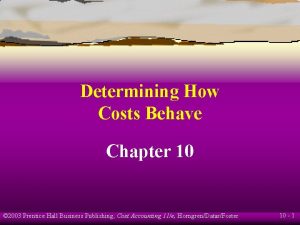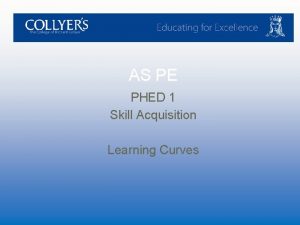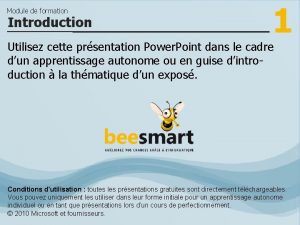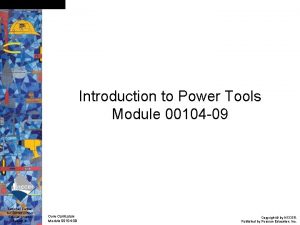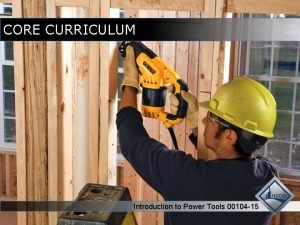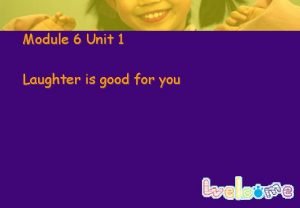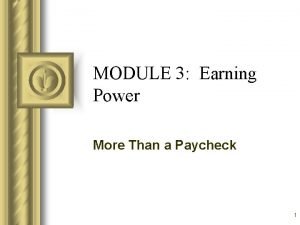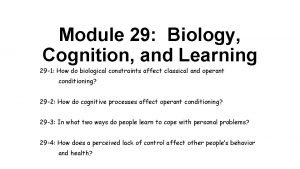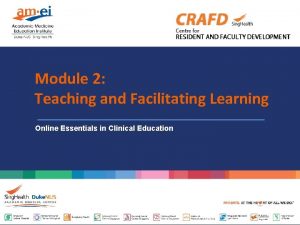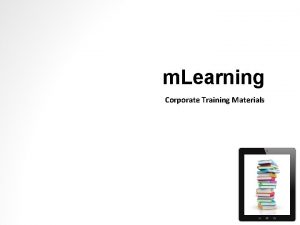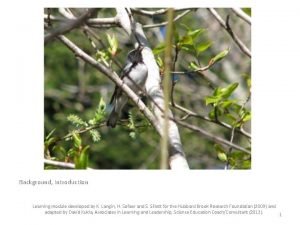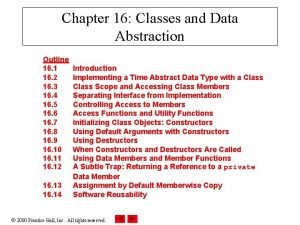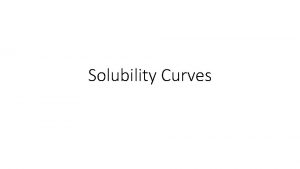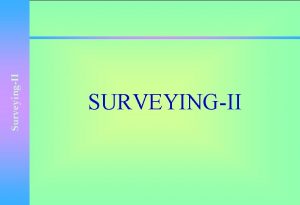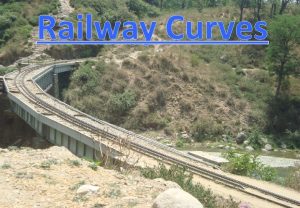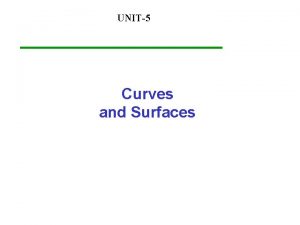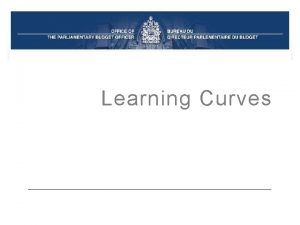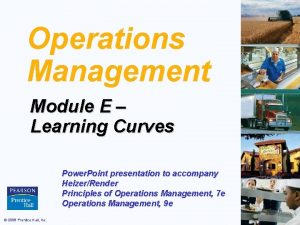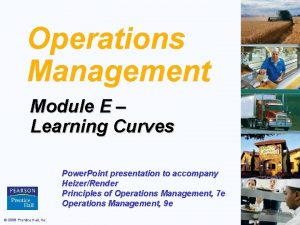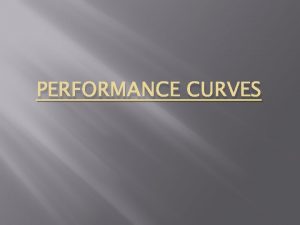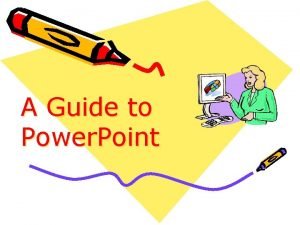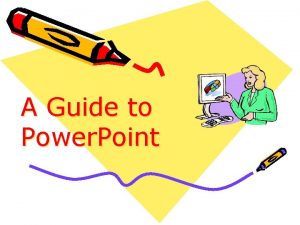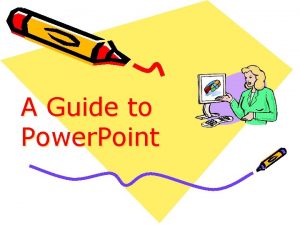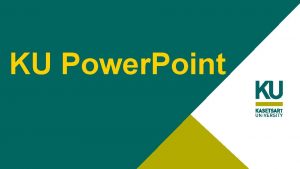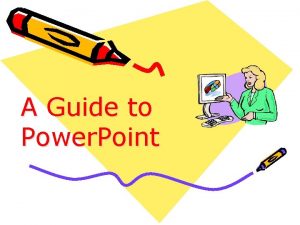E MODULE Learning Curves Power Point presentation to


























- Slides: 26

E MODULE Learning Curves Power. Point presentation to accompany Heizer and Render Operations Management, Eleventh Edition Principles of Operations Management, Ninth Edition Power. Point slides by Jeff Heyl © 2014 Pearson Education, Inc. © 2014 Pearson Education, ME - 1

Outline ► ► ► What Is a Learning Curve? Learning Curves in Services and Manufacturing Applying the Learning Curve Strategic Implications of Learning Curves Limitations of Learning Curves © 2014 Pearson Education, Inc. ME - 2

Learning Objectives When you complete this chapter you should be able to: 1. Define learning curve 2. Use the doubling concept to estimate times 3. Compute learning-curve effects with the formula and learning-curve table approaches 4. Describe the strategic implications of learning curves © 2014 Pearson Education, Inc. ME - 3

What Is a Learning Curves ▶ Based on the premise that people and organizations become better at their tasks as the tasks are repeated ▶ Time to produce a unit decreases as more units are produced ▶ Learning curves typically follow a negative exponential distribution ▶ Time savings per unit decreases over time © 2014 Pearson Education, Inc. ME - 4

Learning Curve Effect Exponential graph of learning Cost or time per repetition Figure E. 1(a) 100 – 50 – 0 © 2014 Pearson Education, Inc. | | 25 50 75 100 Cumulative repetitions (volume) ME - 5

Learning Curve Effect Log-log graph of learning Cost or time per repetition 100 Figure E. 1(b) 50 40 30 20 10 © 2014 Pearson Education, Inc. 20 30 40 50 100 Cumulative repetitions (volume) ME - 6

Learning Curves T x Ln = Time required for the nth unit where T = unit cost or unit time of the first unit L = learning curve rate n = number of times T is doubled First unit takes 10 labor-hours 70% learning curve is present Fourth unit will require doubling twice — 1 to 2 to 4 Hours required for unit 4 = 10 x (. 7)2 = 4. 9 hours © 2014 Pearson Education, Inc. ME - 7

Learning Curve Examples TABLE E. 1 Examples of Learning-Curve Effects IMPROVING EXAMPLE PARAMETERS 1. Model -T Ford Price production CUMULATIVE PARAMETER Units produced LEARNINGCURVE SLOPE (%) 86 2. Aircraft assembly Direct labor-hours per unit Units produced 80 3. Equipment maintenance at GE Average time to replace Number of a group of parts replacements © 2014 Pearson Education, Inc. 76 ME - 8

Learning Curve Examples TABLE E. 1 EXAMPLE 4. Steel production 5. Integrated circuits 6. Handheld calculator a Examples of Learning-Curve Effects IMPROVING PARAMETERS Production worker labor -hours per unit produced Average price per unit CUMULATIVE PARAMETER Units produced LEARNINGCURVE SLOPE (%) 79 Units produced 72 a Average factory selling price Units produced 74 Constant dollars © 2014 Pearson Education, Inc. ME - 9

Learning Curve Examples TABLE E. 1 Examples of Learning-Curve Effects LEARNINGCURVE SLOPE (%) 76 IMPROVING PARAMETERS Average price per bit CUMULATIVE PARAMETER Number of bits 8. Heart transplants 1 -year death rates Transplants completed 79 9. Caesarean section baby deliveries Average operation time Number of surgeries 93 EXAMPLE 7. Disk memory drives © 2014 Pearson Education, Inc. ME - 10

Learning Curves in Services and Manufacturing ► ► Different organizations have different learning curves Any change in process, product, or personnel disrupts the learning curve © 2014 Pearson Education, Inc. ME - 11

Learning Curves in Services and Manufacturing Internal: Labor forecasting, scheduling, establishing costs and budgets External: Supply-chain negotiations Strategic: Evaluation of company and industry performance, including costs and pricing © 2014 Pearson Education, Inc. ME - 12

Applying the Learning Curve ▶ Doubling approach ▶ Simplest approach ▶ Labor cost declines at a constant rate, the learning curve rate, as production doubles ▶ Does not work for other production quantities © 2014 Pearson Education, Inc. ME - 13

Applying the Learning Curve ▶ For an 80% learning rate NTH UNIT PRODUCED HOURS FOR NTH UNIT 1 100. 0 2 80. 0 = (. 8 x 100) 4 64. 0 = (. 8 x 80) 8 51. 2 = (. 8 x 64) 16 41. 0 = (. 8 x 51. 2) © 2014 Pearson Education, Inc. ME - 14

Formula Approach Determine labor for any unit, TN , by TN = T 1(Nb) where TN = time for the Nth unit T 1 = time to produce the first unit b = (log of the learning rate)/(log 2) = slope of the learning curve © 2014 Pearson Education, Inc. ME - 15

Formula Approach TABLE E. 2 Determine labor for any unit, TN , by Learning-Curve Values of b TN = T 1(Nb)LEARNING RATE (%) 70 where b –. 515 TN = time for the Nth unit 75 –. 415 T 1 = time to produce the first unit b = (log of the learning 80 rate)/(log 2)–. 322 = slope of the learning 85 curve –. 234 90 © 2014 Pearson Education, Inc. –. 152 ME - 16

Using Logs Learning rate = 80% First unit took 100 hours TN = T 1(Nb) T 3 = (100 hours)(3 b) = (100)(3 log. 8/log 2) = (100)(3–. 322) = 70. 2 labor hours © 2014 Pearson Education, Inc. ME - 17

Learning Curve Table Approach T N = T 1 C where TN = number of labor-hours required to produce the Nth unit T 1 = number of labor-hours required to produce the first unit C = learning-curve coefficient found in Table E. 3 © 2014 Pearson Education, Inc. ME - 18

Learning-Curve Coefficients TABLE E. 3 Learning-Curve Coefficients, Where Coefficient, C = N(LOG OF LEARNING RATE/LOG 2) 70% UNIT NUMBER (N) 1 2 3 4 5 10 15 20 UNIT TIME COEFFICIENT 1. 000. 700. 568. 490. 437. 306. 248. 214 © 2014 Pearson Education, Inc. 85% TOTAL TIME COEFFICIENT 1. 000 1. 700 2. 268 2. 758 3. 195 4. 932 6. 274 7. 407 UNIT TIME COEFFICIENT 1. 000. 850. 773. 723. 686. 583. 530. 495 TOTAL TIME COEFFICIENT 1. 000 1. 850 2. 623 3. 345 4. 031 7. 116 9. 861 12. 402 ME - 19

Coefficient Example First boat required 125, 000 hours Labor cost = $40/hour Learning factor = 85% T N = T 1 C T 4 = (125, 000 hours)(. 723) = 90, 375 hours for the 4 th boat 90, 375 hours x $40/hour = $3, 615, 000 T N = T 1 C T 4 = (125, 000 hours)(3. 345) = 418, 125 hours for all four boats © 2014 Pearson Education, Inc. ME - 20

Coefficient Example Third boat required 100, 000 hours Learning factor = 85% New estimate for the first boat 100, 000 = 129, 366 hours. 773 © 2014 Pearson Education, Inc. ME - 21

Strategic Implications If a firm’s strategy is to follow a steeper curve than the rest of the industry, they can do this by: 1. Following an aggressive pricing policy 2. Focusing on continuing cost reduction and productivity improvement 3. Building on shared experience 4. Keeping capacity ahead of demand © 2014 Pearson Education, Inc. ME - 22

Industry and Company Learning Curves Le ar Price per unit (log scale) Le a co rn m in pa g ny Loss nin gc cu r ve co fo r st ur ve for ind us (c) try pr ice Selling price (b) Gross profit margin (a) Figure E. 2 Accumulated volume (log scale) © 2014 Pearson Education, Inc. ME - 23

Limitations of Learning Curves ▶ Learning curves differ from company to company as well as industry to industry so estimates should be developed for each organization ▶ Learning curves are often based on time estimates which must be accurate and should be reevaluated when appropriate © 2014 Pearson Education, Inc. ME - 24

Limitations of Learning Curves ▶ Any changes in personnel, design, or procedure can be expected to alter the learning curve ▶ Learning curves do not always apply to indirect labor or material ▶ The culture of the workplace, resource availability, and changes in the process may alter the learning curve © 2014 Pearson Education, Inc. ME - 25

All rights reserved. No part of this publication may be reproduced, stored in a retrieval system, or transmitted, in any form or by any means, electronic, mechanical, photocopying, recording, or otherwise, without the prior written permission of the publisher. Printed in the United States of America. © 2014 Pearson Education, Inc. ME - 26
 Module 5 topic 2 drivers ed
Module 5 topic 2 drivers ed Presentation topics for students in hindi
Presentation topics for students in hindi Power point presentation design west vancouver
Power point presentation design west vancouver Learning curves 2003
Learning curves 2003 Learning curves in sport
Learning curves in sport Learning curve operations management
Learning curve operations management Active power reactive power apparent power
Active power reactive power apparent power Power bi training powerpoint
Power bi training powerpoint Point point power
Point point power Cuadro comparativo de e-learning b-learning y m-learning
Cuadro comparativo de e-learning b-learning y m-learning C device module module 1
C device module module 1 Présentation module de formation
Présentation module de formation Module 4 introduction to power tools test
Module 4 introduction to power tools test 00104 power tools
00104 power tools The power of laughter module c
The power of laughter module c Module 3 earning power
Module 3 earning power Learning: module 26: magnetic forces and fields
Learning: module 26: magnetic forces and fields Icici learning matrix answers pdf
Icici learning matrix answers pdf Module 29 biology cognition and learning
Module 29 biology cognition and learning Learning: module 2: section 19_03-19_05
Learning: module 2: section 19_03-19_05 Facilitating learning module 2
Facilitating learning module 2 Corporate training materials
Corporate training materials Module 31
Module 31 Iec e learning module 2
Iec e learning module 2 Iec e learning module 1
Iec e learning module 1 Learning module background
Learning module background Learning: module 4: section 16_07-16_08
Learning: module 4: section 16_07-16_08



